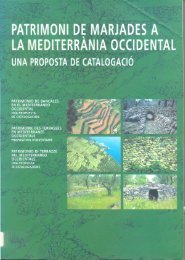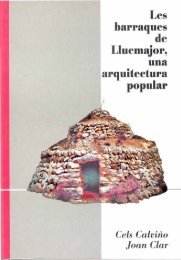La pedra en sec. Materials, eines i tècniques tradicionals a les illes ...
La pedra en sec. Materials, eines i tècniques tradicionals a les illes ...
La pedra en sec. Materials, eines i tècniques tradicionals a les illes ...
You also want an ePaper? Increase the reach of your titles
YUMPU automatically turns print PDFs into web optimized ePapers that Google loves.
*** *<br />
: 6 6.1 DRYSTONE MASONRY STRUCTURES<br />
***<br />
SUPPORTING<br />
STRUCTURES.<br />
RETAINING WALLS<br />
Marges or terrace walls are drystone<br />
walls which are used to create and<br />
hold in a flat or slightly sloping area<br />
which is normally used for farming<br />
and called a marjada (terraced field)<br />
and bancal in the past.<br />
These walls are some of the most<br />
outstanding drystone masonry features<br />
in Majorca, especially in the<br />
"Serra de Tramuntana" where they<br />
have made it possible to farm the slopes<br />
of the mountains. The first refer<strong>en</strong>ces<br />
date from the 13th c<strong>en</strong>tury and<br />
are a constant feature in docum<strong>en</strong>ts<br />
related to farms in the island. The<br />
importance of these wall is quite clear<br />
since the large area they occupy; A<br />
study of the terraced fields in 15 municipalities<br />
in the "Serra de Tramuntana"<br />
shows that these constructions cover<br />
169.627 km2 which means some<br />
17, 134 km of terrace walls.<br />
The need to prepare sloping farmland<br />
to deal with the danger of erosion<br />
explains why there are so many<br />
of them, but the process of tilling new<br />
land and building terrace walls was<br />
boosted over the c<strong>en</strong>turies by a number<br />
of factors: particularly the high<br />
return on some crops, such as olive<br />
oil and wine; the use of marginal land<br />
through the rotes system (a long-term<br />
r<strong>en</strong>t contract for land in return for tilling<br />
it for the first time and thereafter in<br />
exchange for part of the harvest); tax<br />
exemptions for some crops (as in the<br />
case of vines in Banyalbufar in the<br />
16th c<strong>en</strong>tury); the division of common<br />
land into plots, such as the small olive<br />
groves at s'Estret d'Alaro and the Caimari<br />
rotes which were carved out of<br />
common land in the 17th and 19th<br />
c<strong>en</strong>turies respectively; the dividing up<br />
of large estates which lead to the<br />
creation of numerous farms at the <strong>en</strong>d<br />
of the 19th c<strong>en</strong>tury and at the beginning<br />
of the 20th; and the money sp<strong>en</strong>t<br />
by returned emigrants betwe<strong>en</strong> the<br />
<strong>en</strong>d of the 19th c<strong>en</strong>tury and the<br />
beginning of the 20th.<br />
The promotion of these structures to<br />
improve agricultural developm<strong>en</strong>t on<br />
the island was begun in the 18th c<strong>en</strong>tury<br />
with the Societat Economica d'Amics<br />
del Pais del Regne de Mallorca<br />
(Economic Society of Fri<strong>en</strong>ds of the<br />
Country of the Kingdom of Majorca),<br />
founded in 1778 by governm<strong>en</strong>tal<br />
decree. The idea was to improve traditional<br />
crops (olive trees and vines),<br />
to introduce new ones which were not<br />
th<strong>en</strong> well established (carob and<br />
almond trees), and to r<strong>en</strong>ovate agricultural<br />
techniques and introduce<br />
new irrigation systems. The spreading<br />
and promotion of innovation and techniques<br />
at that time included the construction<br />
of terraced fields and drainage<br />
regulation.<br />
Building techniques would seem to<br />
have improved from th<strong>en</strong> on and thoroughly<br />
worked facings became more<br />
frequ<strong>en</strong>t. In the <strong>sec</strong>ond half of the<br />
19th c<strong>en</strong>tury an important qualitative<br />
step was tak<strong>en</strong> with the roads in the<br />
"Serra de Tramuntana" which led to<br />
the spreading of the technique of<br />
polygonal retaining walls and to bigger<br />
walls, reaching their climax in the<br />
sa Regata retaining wall which is 17m<br />
high and 1800 m2 in area.<br />
Along the same lines of agricultural<br />
improvem<strong>en</strong>t, a Tratado de Agricultura<br />
(Treatise on Agriculture) was published<br />
in the island in 1903 which specifically<br />
m<strong>en</strong>tions the need to clear the<br />
fields of stones and to terrace the land<br />
to prev<strong>en</strong>t soil being washed away by<br />
the rain.<br />
The expansion of agriculture and<br />
h<strong>en</strong>ce of terraced fields continued up<br />
to the start of the 20th c<strong>en</strong>tury, ev<strong>en</strong><br />
though the process of abandoning<br />
land giving a marginal return on the




